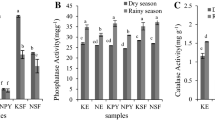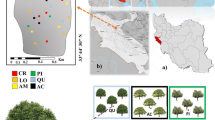Abstract
Riparian forests are important ecosystems especially in arid zones but no information is available about soil enzyme activity in this ecosystem. Therefore, the objectives of this study were to explore some soil enzyme activities and investigate which soil physico-chemical factors affect these soil enzyme activities in riparian forests the most. Tamarix arceuthoides and Populus euphratica that stands close to one another were selected and soil samples were taken from depths of 0–10, 10–20, 20–30, and 30–40 cm. Analysis of variance was performed to detect significant differences in soil enzyme activity and physico-chemical properties between the studied soil depths. Pearson correlation coefficients were also calculated to determine the correlation between soil enzyme activity and soil physico-chemical properties. The results indicate that soil acid and alkaline phosphatase in T. arceuthoides and P. euphratica stands had the highest and lowest values at depths of 0–10 and 30–40 cm, respectively. Soil urease, dehydrogenase, and β-glucosidase had similar results with higher activity in the topsoil compared to the subsoil in both studied stands. Monte Carlo permutation test results of RDA (redundancy analysis) indicated that the most important soil factors to influence enzyme activities in the T. arceuthoides stand are soil nitrogen, organic carbon, and potassium; while the most important factors in the P. euphratica stand are soil nitrogen, organic carbon, moisture, and potassium. Soil moisture is a key factor influencing enzyme activity in the P. euphratica stand. Soil dehydrogenase and β-glucosidase activity in the P. euphratica stand were greater compared to the T. arceuthoides stand. This might indicate greater soil biological activity in the P. euphratica stand compared to the T. arceuthoides stand. Overall, soil moisture, organic matter, and plant species are the key factors effecting soil enzyme activity in riparian forest.





Similar content being viewed by others
References
Adamczyk B, Kilpeläinen P, Kitunen V, Smolander A (2014) Potential activities of enzymes involved in N, C, P and S cycling in boreal forest soil under different tree species. Pedobiologia. 57:97–102
Agren GI, Bosatta E (1996) Quality a bridge between theory and experiment in soil organic matter studies. Oikos 76:522–528
Akhani H (2004) Halophytic vegetation of Iran: towards a syntaxonomical classification. Ann Bot 5:65–82
Amador JA, Glucksman AM, Lyons JB, Gaorres JH (1997) Spatial distribution of soil phosphatase activity within a riparian forest. Soil Sci 162:808–825
Andres Abellan M, Wic Baena C, Garcia Morote FA, Picazo Cordoba MI, Candel Perez D, Lucas-Borja ME (2011) Influence of the soil storage method on soil enzymatic activities in Mediterranean forest soils. Forest Syst 20(3):379–388
Błońska E, Lasota J (2014) Biological and biochemical properties in evaluation of forest soil quality. Folia For Pol 56:23–29
Bremner JM, Mulvaney CS (1982) Nitrogen-total. Part II. Chemical and microbiological properties. In: Miller RH, Keeney DR (eds) Methods of soil analysis, 2nd edn. American Society of Agronomy, Madison, WI, pp 595–624
Cao D, Shi F, Koike T, Lu Z, Sun J (2014) Halophyte plant communities affecting enzyme activity and microbes in saline soils of the Yellow River Delta in China. Clean. Soil Air Water 42:1433–1440. https://doi.org/10.1002/clen.201300007
Celentano D, Rousseau GX, Engel VL, Zelarayán M, Oliveira EC, Araujo ACM, de Moura EG (2016) Degradation of riparian forest affects soil properties and ecosystem services provision eastern Amazon of Brazil. Land Degrad Dev 28:482–493. https://doi.org/10.1002/ldr.2547
Chang EH, Chung RS, Tsai YH (2007) Effect of different application rates of organic fertilizer on soil enzyme activity and microbial population. Soil Sci Plant Nut 53:132–140. https://doi.org/10.1111/j.1747-0765.2007.00122.x
Chen HJ (2003) Phosphatase activity and P fractions in soils of an 18-year-old Chinese fir (Cunninghamia lanceolata) plantation. Forest Ecol Manag 178:301–310
Cheng F, Peng X, Zhao P, Yuan J, Zhong C (2013) Soil microbial biomass, basal respiration and enzyme activity of main forest types in the Qinling Mountains. PLoS ONE 8:e67353. https://doi.org/10.1371/journal.pone.0067353
Chodak M, Niklińska M (2010) The effect of different tree species on the chemical and microbial properties of reclaimed mine soils. Biol Fertil Soils 6:555–566
Clary WP, Booth GD (1993) Early season utilization of mountain meadow pastures. J Range Manag 46:493–497
Dick WA, Tabatabai MA (1993) Significance and potential uses of soil enzymes. In: Blain FJ (ed) Soil microbial ecology application in agricultural and environmental management. Marcel Dekker, NewYork, USA, pp 95–127
Ferreira S, Hjerno K, Larsen M, Wingsle G, Larsen P, Fey S, Roepstorff P, Salomepais M (2006) Proteome profiling of Populus euphratica Oliv. Up on heat stress. Ann Bot 98:361–377
Garcıa C, Hernandez T, Roldan A, Martın A (2002) Effect of plant cover decline on chemical microbiological parameters under Mediterranean climate. Soil Biol Biochem 34:635–642
Groffman PM, Mcdowell WH, Myers JC, Merriam JL (2001) Soil microbial biomass and activity in tropical riparian forests. Soil Biol Biochem 33:1339–1348
Horváth B, Opara-Nadi O, Beese F (2005) A simple method for measuring the carbonate content of soils. Soil Sci Soc Am J 69:1066–1068
Makoi JHR, Ndakidemi PA (2008) Selected soil enzymes: examples of their potential roles in the ecosystem. Afr J Biotechnol 7:181–191
Medina-Villar S, Castro-Díez P, Alonso A, Cabra-Rivas I, Parker IM, Pérez-Corona E (2015) Do the invasive trees, Ailanthus altissima and Robinia pseudoacacia, alter litter fall dynamics and soil properties of riparian ecosystems in Central Spain? Plant. Soil 396:311–324
Moradi Behbahani S, Moradi M, Basiri R, Mirzaei J (2017) Sand mining disturbances and their effects on the diversity of arbuscular mycorrhizal fungi in a riparian forest of Iran. J Arid land 9:837–849
Moradi M, Shirvany A, Matinizadeh M, Etemad V, Naji HR, Abdul-Hamid H, Sayah S (2015) Arbuscular mycorrhizal fungal symbiosis with Sorbus torminalis does not vary with soil nutrients and enzyme activities across different sites. iForest 8:308–313. https://doi.org/10.3832/ifor1236-008
Moradi M, Imani F, Naji HR, Moradi Behbahani S, Ahmadi MT (2017) Variation in soil carbon stock and nutrient content in sand dunes after afforestation by Prosopis juliflorain the Khuzestan province (Iran). iForest 10:585–589
Morwin HD, Peach PM (1951) Exchangeability of soil potassium in and, silt and clay fractions as influenced by the nature of complementary exchangeable cations. Soil Sci Soc Am J 15:125–128
Nannipieri P, Giagnoni L, Renella G, Puglisi E, Ceccanti B, Masciandaro G, Fornasier F, Moscatelli MC, Marinari S (2012) Soil enzymology: classical and molecular approaches. Biol Fertil Soils 48:743–762
Ohlinger R (1996) Acid and alkaline phosphomonoesterase activity with the substrate p-nitrophenyl phosphate. In: Schinner F, Kandeler E, Ohlinger R, Margesin R (eds) Methods in soil biology. Springer-Verlag, Berlin, pp 210–214
Olsen SR, Cole CV, Watanabe FS, Dean LA (1954) Estimation of available phosphorus in soils by extraction with sodium bicarbonate. USDA, Washington, DC, USA. 939:1–19
Pascual JA, Moreno JL, Hernandez T, Garcia C (2002) Persistence of immobilised and total urease and phosphatase activities in a soil amended with organic wastes. Bioresour Technol 82:73–78
Raiesi F, Beheshti A (2014) Soil specific enzyme activity shows more clearly soil responses to paddy rice cultivation than absolute enzyme activity in primary forests of northwest Iran. Appl Soil Ecol 75:63–70
Rao MA, Violante A, Gianfreda L (2000) Interaction of acid phosphatase with clays, organic molecules and organo-mineral complexes: kinetics and stability. Soil Biol Biochem 32:1007–1014
Rieger I, Lang F, Kowarik I, Cierjacks A (2014) The interplay of sedimentation and carbon accretion in riparian forests. Geomorphology 214:157–167
Sardans J, Penuelas J (2005) Drought decrease soil enzyme activity in a Mediterranean Quercus ilex L. Forest. Soil Biol Biochem 37:455–461
Schinner F, Öhlinger R, Kandeler E, Margesin R (1996) Methods in soil biology. Springer-Verlag, Berlin
Tabatabai MA (1994) Soil Enzymes. In: Methods of Soil Analysis; Microbiological and Biochemical Properties, Weaver, R. W. Angle, J. S and P. S. Botttomley (Eds.). Madison, WI: Soil Science Society of America, pp 775–833
Tian Y, Cao F, Wang G (2013) Soil microbiological properties and enzyme activity in Ginkgo–tea agroforestry compared with monoculture. Agroforest Syst 87:1201–1210
Ushio M, Wagai R, Balser TC, Kitayama K (2008) Variations in the soil microbial community composition of a tropical montane forest ecosystem. does tree species matter? Soil Biol Biochem 40:2699–2702
Ushio M, Kitayama K, Balser TC (2010) Tree species effects on soil enzyme activities through effects on soil physicochemical and microbial properties in a tropical montane forest on Mt, Kinabalu, Borneo. Pedobiologia 53:227–233
Venkatesan S, Senthurpandian VK (2006) Comparison of enzyme activity with depth under tea plantations and forested sites in south India. Geoderma 137:212–216
Walkley A, Black IA (1934) An examination of Degtjareff method for determining soil organic matter and a proposed modification of the chromic acid titration method. Soil Sci 37:29–37
Wang B, Xue S, Liu GB, Zhang GH, Li G, Ren ZP (2012) Changes in soil nutrient and enzyme activities under different vegetations in the Loess Plateau area, Northwest China. Catena 92:186–195
Wang W, Dumroese DP, Lv R, Xiao C, Li G, Liu Y (2016) Soil enzyme activity in Pinus tabuliflora (Carriere) plantations in northern china. Forests 7:112–124
Wang W, Zhong Z, Wang Q, Wang H, Fu Y, He X (2017) Glomalin contributed more to carbon, nutrients in deeper soils, and differently associated with climates and soil properties in vertical profiles. Sci Rep 7:e13003. https://doi.org/10.1038/s41598-017-12731-7
Xiao S, You H, You W, Liu J, Cai C, Wu J, Ji Z, Zhan S, Hu Z, Zhang Z, He D (2016) Rhizosphere and bulk soil enzyme activities in a Nothotsuga longibracteata forest in the Tianbaoyan National Nature Reserve, Fujian Province, China. J For Res 28:521–528. https://doi.org/10.1007/s11676-016-0334-y
Acknowledgements
Special thanks to Behbahan Khatam Alanbia University of Technology for financial support of this work. Also, great thanks to the anonymous reviewers for their valuable comments and suggestions on our manuscript. Ruhollah Taghizadeh-Mehrjardi has been supported by the Alexander von Humboldt Foundation under the grant number: Ref3.4-1164573-IRN-GFHERMES-P.
Author information
Authors and Affiliations
Corresponding author
Additional information
Responsible Editor: Domenico M. Doronzo
Rights and permissions
About this article
Cite this article
Avazpoor, Z., Moradi, M., Basiri, R. et al. Soil enzyme activity variations in riparian forests in relation to plant species and soil depth. Arab J Geosci 12, 708 (2019). https://doi.org/10.1007/s12517-019-4910-2
Received:
Accepted:
Published:
DOI: https://doi.org/10.1007/s12517-019-4910-2




